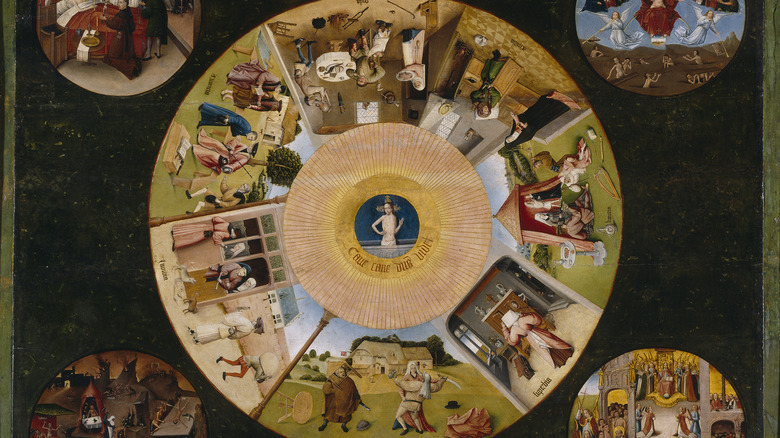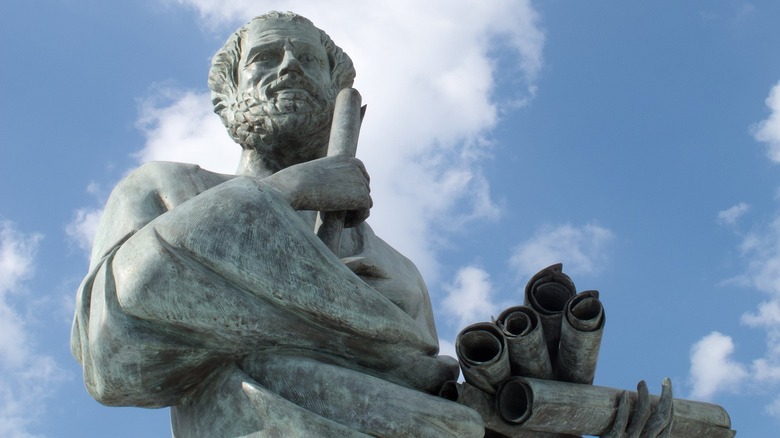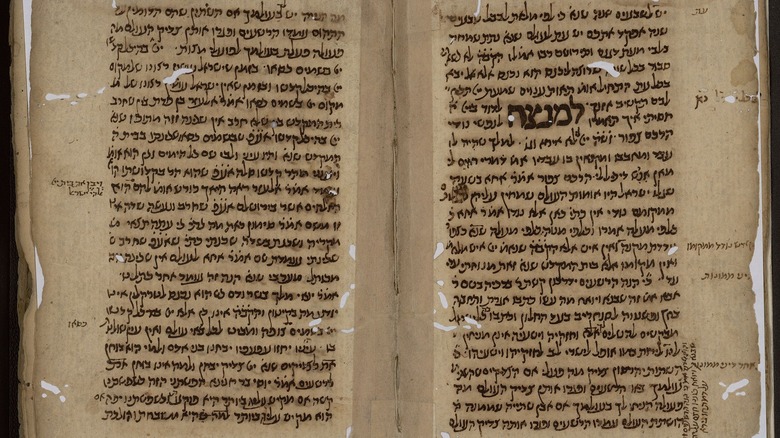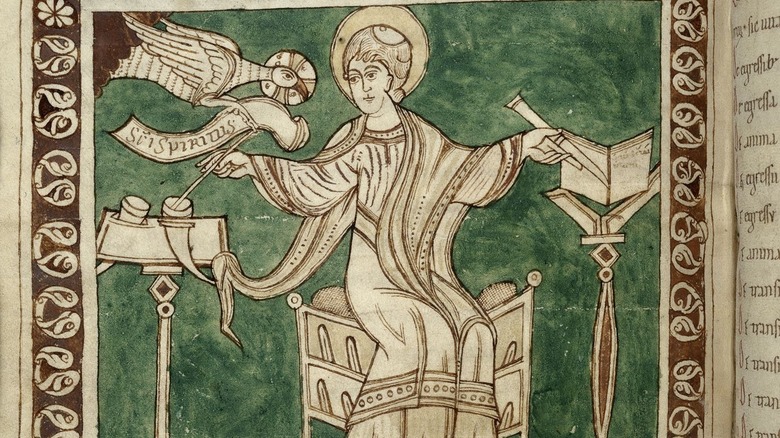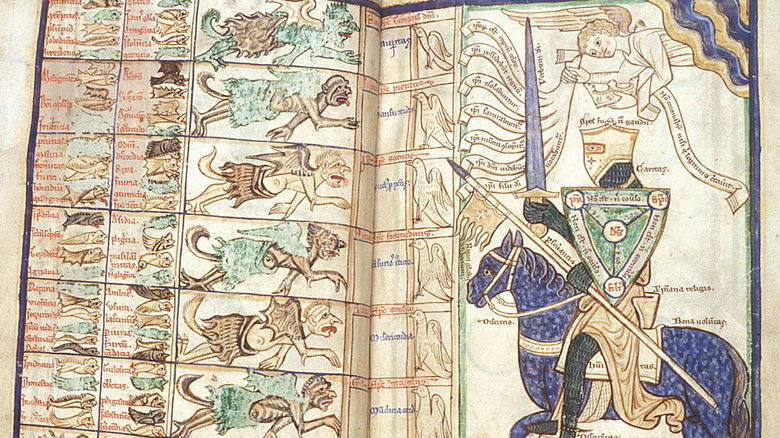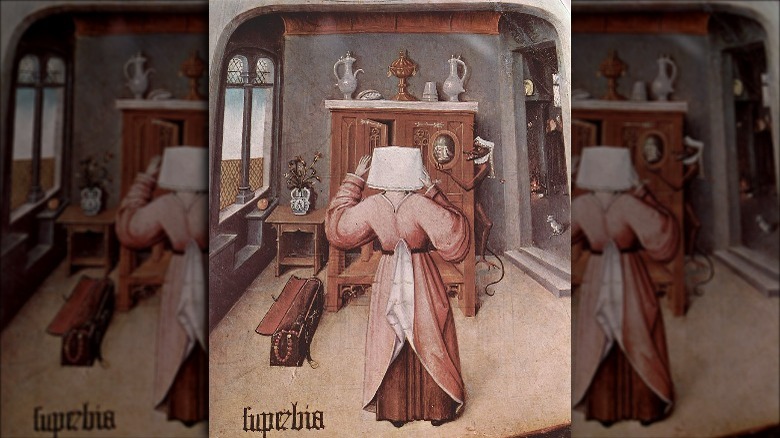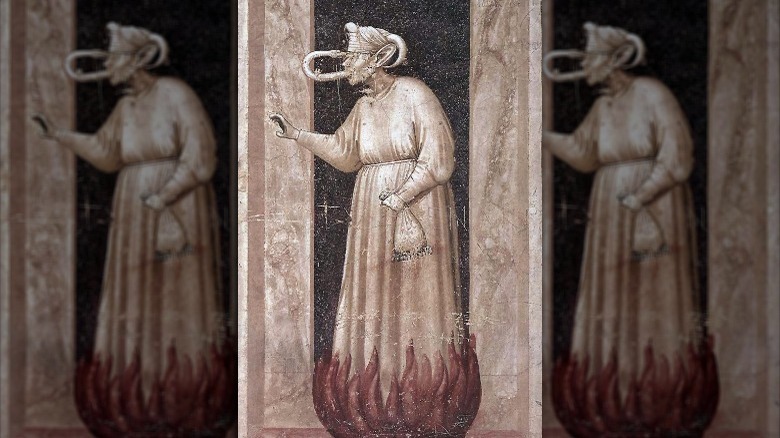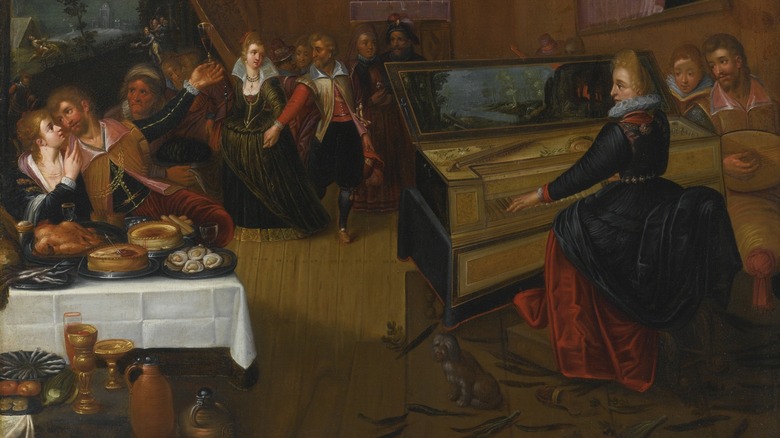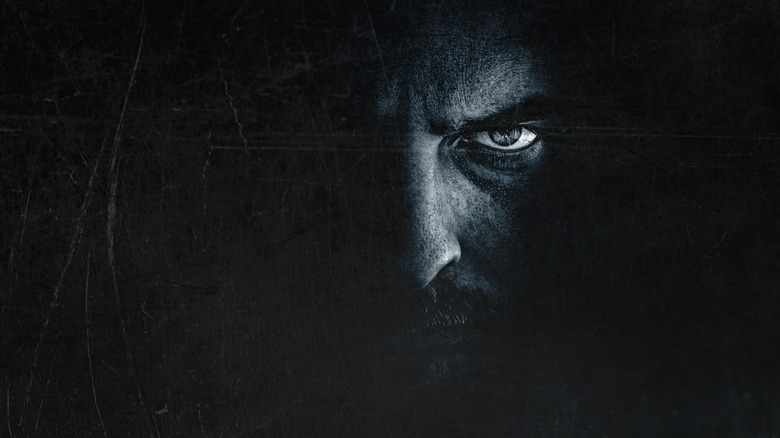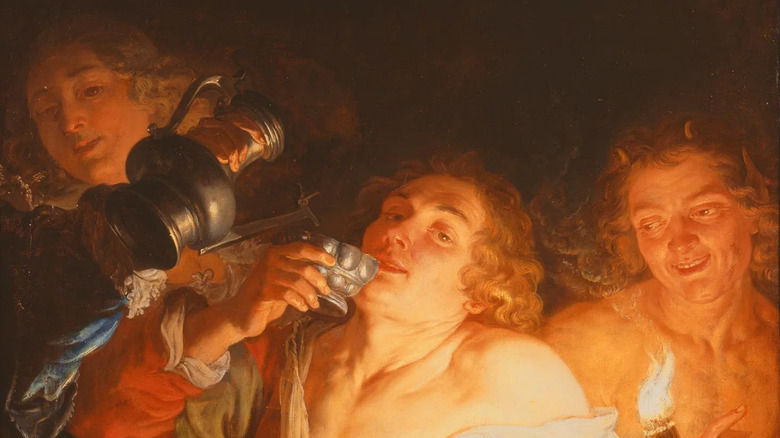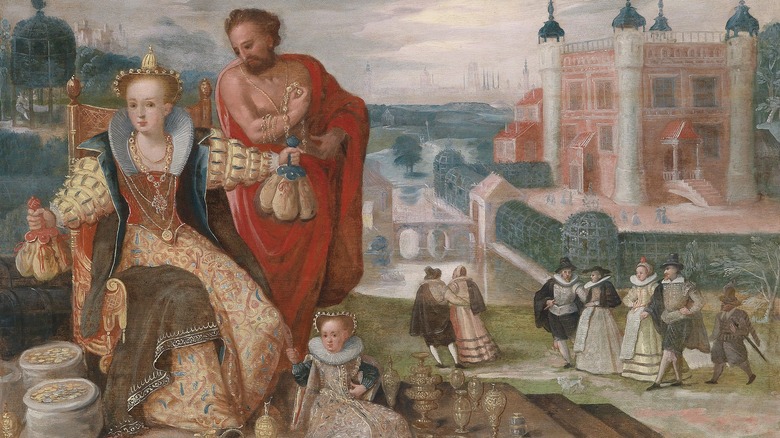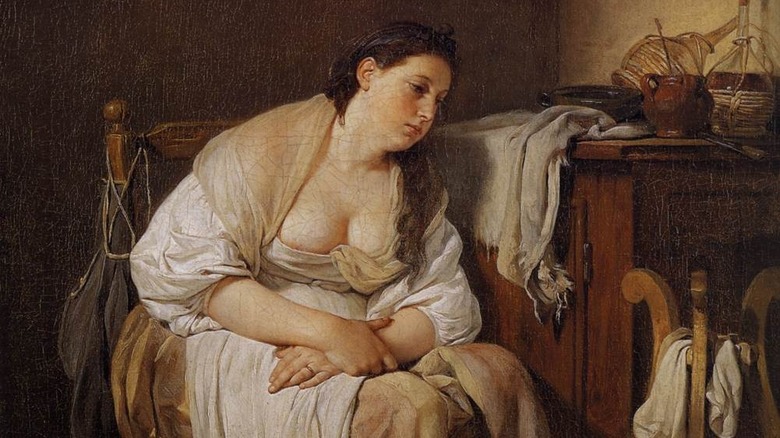The Untold Truth Of The Seven Deadly Sins
You may think you're already pretty familiar with the concept of the seven deadly sins. You may even be able to rattle them off fairly easily, perhaps recalling the latest book, movie, or TV show that references the concept. But if you need a refresher, no worries. As they're generally understood today, the sins in question include: lust, gluttony, greed, sloth, wrath, envy, and pride. Indulging in any one of these sins could get you into a pretty bad place, morally speaking. And, if you're a believer in Abrahamic religions like Christianity, you may also believe that any one of these sins could put you on a dark path towards damnation.
But how much do we really know about the seven deadly sins? After all, History reports that there weren't even seven in the first place — at least not when Christian monks started discussing the matter in the 4th century. In reality, the concept of those ultra-awful sins may be a bit more modern than you think, having come to us filtered through centuries of folklore, pop culture, and theological dissertations. This is the untold truth of the seven deadly sins.
Greek and Roman philosophers got the seven deadly sins rolling
People have been pretty fond of listing off various prescriptions for how to behave for millennia, long before the Hebrew scriptures and the birth of Christ. The ancient Greek philosopher Aristotle listed a series of virtues and vices in his own works, "Nicomachean Ethics" and "Eudemian Ethics"(via the Stanford Encyclopedia of Philosophy). Aristotle argued that true virtue is a balanced point between two extremes of excess and deficiency. For example, acting too rashly is bad, while being too shy and cowardly is no good, either. The ideal balancing point between the two is therefore courage.
According to "The Seven Deadly Sins: From Communities to Individuals," Aristotle also claimed that there was a distinction between temperance and continence, at least when it came to one's moral state. A temperate person is naturally virtuous, while a continent one has all manner of desires but still actively chooses to follow the righteous, balanced ones in spite of temptation. The Roman poet Horace also seemed fond of listing virtues and vices. In his book "Epistles," he wrote that it was important to "flee vice," which he rather helpfully listed.
Jewish theology has a similar concept
The pre-Christian antecedents to the seven deadly sins don't just stop with moralizing philosophers in ancient Greece and Rome. Many schools of Jewish thought discuss "good inclination" and "evil inclination," defined as yetzer ha-tov and yetzer ha-ra, respectively (per Oxford Reference).
Rabbis discussing ancient texts in a form of interpretation called a "midrash" generally make it clear that evil inclinations are a fundamental part of human nature that every person must grapple with throughout their lives. In fact, that struggle is ongoing and is oftentimes best supported by a commitment to the faith and to a deep relationship with the Torah. According to the Jewish Encyclopedia, yetzer ha-ra, also sometimes written as Yeẓer ha-Ra', are impulses that can be personified and associated with evil figures such as Satan. It's rarely made out to be quite the same thing as the devil — or in some cases, the angel of death — but more like a set of influences that accompany evil personified.
Critically, the situation isn't quite as simple as urging people to completely deny and fight against yetzer ha-ra. It's part of a greater cosmic balance that can push humans towards a greater, more noble path by its example. Though, like all sins and vices, it can present a perilously narrow road at times.
The Christian take began as eight evil thoughts
After all of the various lists and takes on sin floating around in the ancient world over the years, it wasn't until the 4th century that the steadily growing Christian movement began to put its own spin on what constituted sin. And it certainly didn't emerge as the list of seven deadly sins that many of us know today.
Per History, it all started with a reclusive Christian monk named Evagrius Ponticus. He wrote down a list of "eight evil thoughts" that could plague his fellow monastics as they tried to become closer with God and resist the temptations and corruption of the world. Those eight evil thoughts were: gluttony, lust, avarice, anger, sloth, sadness, vainglory, and pride.
Evagrius, however, wasn't necessarily writing for a wider audience. He was also involved with the Eastern Christian Church, and it took the work of his pupil, John Cassian, to bring Evagrius' list to wider attention in the Western branch of the church. And even though the list was translated into Latin for a broader set of readers, it still knocked around for another two centuries or so before it truly began to take hold in the wider Christian world.
The seven deadly sins weren't church canon until the 6th century
Officially speaking, the Christian concept of the seven deadly sins didn't begin to take hold until the idea was formally sponsored, so to speak, by one of the biggest names in Christendom: the pope. In the 6th century, History reports, Pope Gregory I (also known as Gregory the Great) got a copy of Evagrius Ponticus' list and rearranged it into the seven deadly sins. He debuted the new take on vice in his analysis of the Bible's Book of Job, having rearranged some of the previous list; for example, he switched envy in for sloth.
Encylopedia.com also notes that Gregory folded sloth into a broader sin categorized as "melancholy." Perhaps most notably, he decreed that pride was really the worst of all sins. According to Gregory's estimation of things, it was at the root of all of the other deadly offenses. St. Thomas Aquinas, a Christian writer working in the 13th century, later agreed with Pope Gregory, explaining that pride is essentially a form of thumbing your nose at God's will and authority.
Medieval Christians really took to the idea of the seven deadly sins
In a world where learned commentaries and Latin Bibles were only really available to a literate few, the speeches delivered by local priests and the lessons imparted in church artworks were key to maintaining religious orthodoxy. And, given that the seven deadly sins seem ready-made for graphic representation, it's no wonder that medieval Europe went positively gaga over the concept.
According to the Oxford Research Centre, it didn't end just at murals or moralizing sermons. Medieval Christians saw the seven deadly sins reflected in their churches, art, plays, and many more arenas, often under Latin names and with a sometimes complicated hierarchy of sin and its various "fruits." Of course, even if someone didn't quite grasp the many ways in which the deadly sins could be dissected and analyzed, they would have been well aware of the effects of such evildoing in their lives. And, if they were aware, they could more easily make confession to their local priest, get absolution, do penance, and maybe make it out of their earthly life with only a temporary purgatory sentence and not outright damnation.
Medieval sources also often outline "seven works of mercy" that could help parishioners avoid the worst consequences of sin. These included more action-oriented tasks, like giving out food and water, donating clothing, and making sure that the dead received a proper burial.
Pride is often considered the worst of the deadly sins
Since practically the beginning of the seven deadly sins as a Christian concept, theologians have zeroed in on pride as the worst of them all. But why is it so much more vile than, say, lust or greed? First, as NPR reports, pride is one of those rather vague sins that, despite its deadly classification, is kind of hard to nail down. It can be applied in any number of ways, from hubris to more everyday snootiness. Ultimately, however, it boils down to thinking that you are not only better, smarter, and more capable than your human neighbors, but that you might even exceed the intelligence of God.
Within the confines of Christian theology, being smarter than God is just about impossible for any person and can only lead to a rather deadly kind of arrogance. If you think you're better than a deity or its representatives, then you probably won't want to humble yourself and take their advice, after all. And, as Encyclopedia.com notes, philosophers and theologians like Pope Gregory I believed that pride is ultimately at the root of all other sins.
Envy is really about bitterness
Envy is most often described as wanting what your neighbor has, to the point where your relationship with this person is utterly destroyed. It's not exactly about wanting a physical object, though. As "Glittering Vices" notes, envy is a bit more refined than that. It's really about wanting the status that is associated with having something. For example, wanting the acclaim and admiration that often comes along with having a large, richly appointed mansion rather than the home itself.
According to "Envy: The Seven Deadly Sins," it is also often understood as a "cold-blooded" sin that's linked more to a person's thoughts than passionate urges. While someone might thoughtlessly give in to something like lust or wrath, the sin of envy requires a certain kind of calculation that's often done consciously and perhaps even over an extended period of time. For many, this also means that cold-blooded sins (which can also include pride, sloth, and greed) are worse than the heated ones, not least because someone has had the opportunity to think better and choose a more virtuous path.
Lust isn't just about naughty things
Though it's often interpreted as dealing in only sins of a sexual nature, lust is also sometimes about the desire for earthly and sensual pleasures beyond the bedroom. In addition, Cambridge University philosophy professor Simon Blackburn said in an interview with NPR that this sin is somewhat central to life as a human. Unless, of course, you'd prefer a pretty colorless life as a squeaky clean and completely inoffensive monk or nun, for instance.
Still, it's hard to get away from the sex-related aspect of lust. As History reports, the Catechism of the Catholic Church defines it as "inordinate enjoyment of sexual pleasure," especially when it's been separated from what the church defines as the act's essential purpose of bringing a married couple together or for making babies. Even taking too much pleasure in it while married can still be considered a sin.
Deciding just who's responsible for lust and how to control it has plagued people for centuries, says "The Seven Deadly Sins." It's especially tough to grapple with, given that even the most seemingly intelligent people who live a highly ordered life of the mind can still be felled by lust.
Wrath is more than just anger
Oftentimes, people sum up the deadly of wrath as "anger" and leave it at that. But while wrath certainly does include getting mad, it's a bit more complicated than that. Remember that there are certainly occasions where anger can be righteous and justified. In fact, even Jesus is known to have fell victim to anger, as in the rather infamous incident related in Matthew 21:12-13. In the text, he enters the temple, flips a few tables, and upsets money leaders working there.
So, if even Jesus is allowed to get angry every once in a while, when does it all tip over into deadly sin? According to the Catechism of the Catholic Church, this emotion becomes wrath when it becomes a "deliberate desire to kill or seriously wound a neighbor." And Dante, the medieval Italian poet who was exiled because of political infighting in Florence (via History), zeroed in on wrath as it's expressed through vengeance, according to Columbia University's Digital Dante project.
Some have made the distinction that the sin of wrath must involve the conscious intent to hurt people or even one's self, per History. Medieval artworks showing the sin didn't just show humans harming each other but also committing harm towards themselves in hot-blooded, unthinking wrath aimed inwards.
Gluttony covers sins of overindulgence
For medieval church leaders, gluttony wasn't just about stuffing your face with food. It was also about being overly luxurious with your meals, eating too much, too quickly, or too eagerly. Really, enjoying food too much or not respecting its role in maintaining one's body is enough to pin you under the mortal sin of gluttony. According to "The Seven Deadly Sins," it's one of the most common sins to follow Christians throughout various iterations of the seven deadly sins. Perhaps this longevity is because it was considered a special issue for monks and other monastics who specifically tried to avoid these sorts of worldly temptations.
For many scholars and religious commentators, gluttony is at its worst when overindulgence gets in the way of one's spiritual life, drawing in the fellow sins of greed and lust in a way that leads someone astray. Gluttony is another one of those "hot-blooded" sins, which many have also categorized as relatively thoughtless, animalistic urges that need to be carefully recognized and opposed, lest they lead us astray. In Pope Gregory I's "Moralia," the 6th-century pontiff argues that the sin of gluttony essentially comes at you from five directions, including sins of wanting too fine food and of not planning for its distribution properly.
Greed is all about material goods
If envy is the cold-blooded covetousness of someone else's acclaim and general life, then greed is its more thoughtless cousin. Sometimes also known as "avarice," greed is generally understood to be the hoarding of both money and other forms of wealth. According to "The Seven Deadly Sins," medieval monk and philosopher Roger Bacon despised greed so much that he placed it in the lead for the worst deadly sin and claimed that it was at the root of nearly every other wrongdoing (except for anger). Later writers, like Dante's mentor Brunetto Latini, further subdivided greed into different categories. However, as the medieval age progressed into the Renaissance and merchants became more and more prominent, defining "greed" and balancing the need for money-making with spiritual pursuits became an increasingly thorny issue.
Greed is typically defined as the desire for earthly goods, which grows so strong as to lead the sinner away from God and spiritual life in general, per St. Thomas Aquinas' "Summa Theologica." For his part, Aquinas contended that greed was really another form of pride.
Sloth may be the most confusing of the deadly sins
Sloth is perhaps the hardest of all the seven deadly sins to pin down. For many, simply defining this sin as "laziness" is, well, lazy. For St. Thomas Aquinas, writing in his "Summa Theologica," sloth is "sorrow about spiritual good" that can lead someone to despair or inaction. In other words, he writes, sloth "is an oppressive sorrow, which, to wit, so weighs upon man's mind, that he wants to do nothing."
Per "The Seven Deadly Sins," sloth, also sometimes known as "acedia," can also be expressed as idleness, boredom, and straying from one's true work. And, yes, being overly sleepy and lying about in bed are also symptoms of this wide-ranging sin. In many theological estimations of sloth, its worst offense may be in slowing down not just a person's body but their mind. For if someone is slow to think and consider their place in this world and their actions, how can they ever hope to secure a good place in the next?
The sins are complemented by seven heavenly virtues
If all of these lists of transgressions and the ways you can potentially go astray are bumming you out, you can at least take heart in knowing that there are some ways to counteract the effects of the seven deadly sins. Echoing the words of Aristotle and other ancient and medieval writers, some Christian denominations say that the deadly sins are complemented by unique virtues that could potentially get one off the path to hell or purgatory and towards a more righteous final destination.
So, what are those virtues, exactly? The Archdiocese of Baltimore contends that the "seven capital virtues" meant to oppose the seven deadly sins are: faith, hope, love, prudence, fortitude, justice, and temperance. A similar concept was espoused by 5th-century Christian writer Aurelius Clemens Prudentius, who wrote in his "Psychomachia" of the seven virtues and seven vices facing off in a kind of cosmic battle for souls. Translated from Latin, Prudentius' seven virtues are chastity, temperance, charity, diligence, patience, kindness, and humility (as opposed to lust, gluttony, greed, sloth, wrath, envy, and pride, respectively).
The seven deadly sins are now a pop culture motif
The seven deadly sins are a handy way of categorizing characters and making commentary, to the point where they pop up in places as surprising as "Gilligan's Island." Yes, really. Per NPR, show creator Sherwood Schwartz said each of the main characters of the series is meant to align with one of the seven deadly sins. Ginger was lustful, the Skipper was angry, and the Professor seemingly couldn't keep control over his own pride. For his part, Gilligan was sloth, though some wonder if he might have just been the devil for all the good that he did everyone else.
Of course, that's not the only place you may have seen the seven deadly sins. Vox reports that they have appeared in big-budget films like "Shazam" and the grim David Fincher horror flick "Seven" — sometimes personified and sometimes not. This pop culture zeitgeist may also be why so many people see the seven deadly sins as action-based, rather than evidence of poor habits and disordered thought patterns.
